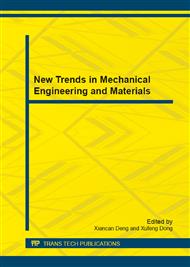[1]
Tom Mcreynolds, David Blythe, Advanced Graphics Programming Using OpenGL, Baker & Taylor Books, 2005, pp.531-570.
DOI: 10.1016/b978-155860659-3.50022-6
Google Scholar
[2]
S. Card, J. MacKinlay, B. Shneiderman, Readings in Information Visualization – UsingVision to Think, Morgan Kaufmann, (1999).
Google Scholar
[3]
YAN Yongnian, LI Shengjie, ZHANG Renji, LIN Feng, WU Rendong, LU Qingping, XIONG Zhuo, WANG Xiaohong, Rapid Prototyping and Manufacturing Technology: Principle, Representative Technics, Applications, and Development Trends, TSINGHUA SCIENCE AND TECHNOLOGY. 14 (2009).
DOI: 10.1049/cp:20061060
Google Scholar
[4]
Takeo Nakagawa, Akitake Makinouchi, Jie Wei, 3-D Plotting of Finite Element Sheet Metal Forming Simulation Results by Laser Stereolithography, CIRP Annals - Manufacturing Technology. 41(1992) 331-333.
DOI: 10.1016/s0007-8506(07)61216-5
Google Scholar
[5]
T. Nakagawa, A. Makinouchi, J. Wei, T. Shimizu, Application of laser stereolithography in FE sheet-metal forming simulation, Journal of Materials Processing Technology. 50(1995) 318-323.
DOI: 10.1016/0924-0136(95)91251-w
Google Scholar
[6]
Suwat Jirathearanat, Victor Vazquez, Ciro A. Rodriguez, Taylan Altan, Virtual processing-application of rapid prototyping for visualization of metal forming processes, Journal of Materials Processing Technology. 98 (2000) 116-124.
DOI: 10.1016/s0924-0136(99)00312-x
Google Scholar
[7]
Yuung-Hwa Lu, Integration of RP and explicit dynamic FEM for the visualization of the sheet metal forming process, Int J Adv Manuf Technol. 28(2006) 255–261.
DOI: 10.1007/s00170-004-2368-0
Google Scholar
[8]
D. Rypl, Z. Bittnar, Generation of computational surface meshes of STL models, Journal of Computational and Applied Mathematics. 192 (2006) 148–151.
DOI: 10.1016/j.cam.2005.04.054
Google Scholar
[9]
M. Szilvśi-Nagy, Gy. Mátyási, Analysis of STL files, Mathematical and Computer Modelling. 38(2003) 945-960.
DOI: 10.1016/s0895-7177(03)90079-3
Google Scholar
[10]
E. Béchet, J. -C. Cuilliere, F. Trochu, Generation of computational surface meshes of STL models, Computer-Aided Design. 34(2002) 1-17.
DOI: 10.1016/s0010-4485(00)00146-9
Google Scholar


